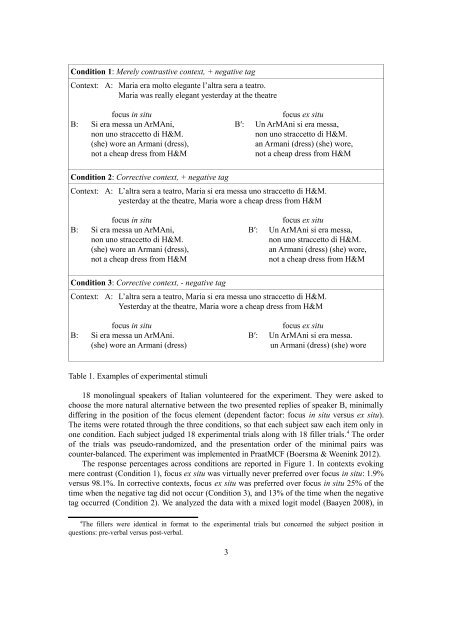Empirical Issues in Syntax and Semantics 9 (EISS 9 ... - CSSP - CNRS
Empirical Issues in Syntax and Semantics 9 (EISS 9 ... - CSSP - CNRS
Empirical Issues in Syntax and Semantics 9 (EISS 9 ... - CSSP - CNRS
Create successful ePaper yourself
Turn your PDF publications into a flip-book with our unique Google optimized e-Paper software.
Condition 1: Merely contrastive context, + negative tag<br />
Context: A: Maria era molto elegante l’altra sera a teatro.<br />
Maria was really elegant yesterday at the theatre<br />
focus <strong>in</strong> situ<br />
focus ex situ<br />
B: Si era messa un ArMAni, B′: Un ArMAni si era messa,<br />
non uno straccetto di H&M.<br />
non uno straccetto di H&M.<br />
(she) wore an Armani (dress),<br />
an Armani (dress) (she) wore,<br />
not a cheap dress from H&M<br />
not a cheap dress from H&M<br />
Condition 2: Corrective context, + negative tag<br />
Context: A: L’altra sera a teatro, Maria si era messa uno straccetto di H&M.<br />
yesterday at the theatre, Maria wore a cheap dress from H&M<br />
focus <strong>in</strong> situ<br />
focus ex situ<br />
B: Si era messa un ArMAni, B′: Un ArMAni si era messa,<br />
non uno straccetto di H&M.<br />
non uno straccetto di H&M.<br />
(she) wore an Armani (dress),<br />
an Armani (dress) (she) wore,<br />
not a cheap dress from H&M<br />
not a cheap dress from H&M<br />
Condition 3: Corrective context, - negative tag<br />
Context: A: L’altra sera a teatro, Maria si era messa uno straccetto di H&M.<br />
Yesterday at the theatre, Maria wore a cheap dress from H&M<br />
focus <strong>in</strong> situ<br />
focus ex situ<br />
B: Si era messa un ArMAni. B′: Un ArMAni si era messa.<br />
(she) wore an Armani (dress) un Armani (dress) (she) wore<br />
Table 1. Examples of experimental stimuli<br />
18 monol<strong>in</strong>gual speakers of Italian volunteered for the experiment. They were asked to<br />
choose the more natural alternative between the two presented replies of speaker B, m<strong>in</strong>imally<br />
differ<strong>in</strong>g <strong>in</strong> the position of the focus element (dependent factor: focus <strong>in</strong> situ versus ex situ).<br />
The items were rotated through the three conditions, so that each subject saw each item only <strong>in</strong><br />
one condition. Each subject judged 18 experimental trials along with 18 filler trials. 4 The order<br />
of the trials was pseudo-r<strong>and</strong>omized, <strong>and</strong> the presentation order of the m<strong>in</strong>imal pairs was<br />
counter-balanced. The experiment was implemented <strong>in</strong> PraatMCF (Boersma & Ween<strong>in</strong>k 2012).<br />
The response percentages across conditions are reported <strong>in</strong> Figure 1. In contexts evok<strong>in</strong>g<br />
mere contrast (Condition 1), focus ex situ was virtually never preferred over focus <strong>in</strong> situ: 1.9%<br />
versus 98.1%. In corrective contexts, focus ex situ was preferred over focus <strong>in</strong> situ 25% of the<br />
time when the negative tag did not occur (Condition 3), <strong>and</strong> 13% of the time when the negative<br />
tag occurred (Condition 2). We analyzed the data with a mixed logit model (Baayen 2008), <strong>in</strong><br />
4<br />
The fillers were identical <strong>in</strong> format to the experimental trials but concerned the subject position <strong>in</strong><br />
questions: pre-verbal versus post-verbal.<br />
3











